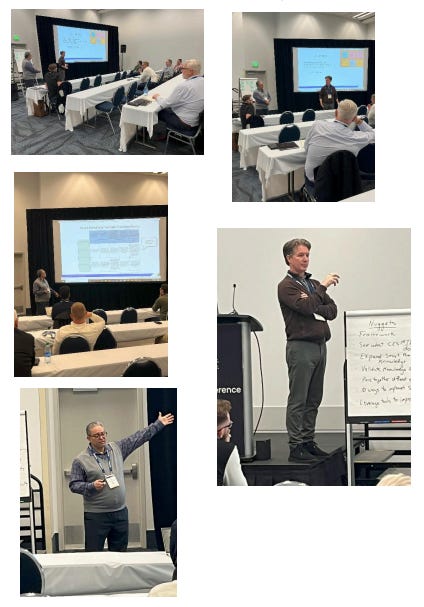🚀 Shaping the Future - Issue 31
Capturing the Highlights: IME West in Images - The Recap Series ⚡️
⚡️ IME West in Images- The Recap Series
Smart Manufacturing Workshop
For the first time at IME West, the Industry 4.0 Club in conjunction with CESMII held the Smart Manufacturing Workshop. This 4-hour event focused on raising awareness of the need to integrate Smart Manufacturing into one’s manufacturing business and educated participants on the elements of a Smart Manufacturing Roadmap. The 6 key elements that were addressed in the Smart Manufacturing Roadmap were Manufacturing Strategy and Leadership, Manufacturing Excellence and Culture, Data-Driven Processes, Connected Systems, Optimized Workforce, and Supply Chain Resilience & Agility.
Conrad Leiva from CESMII and Mike Yost from the Industry 4.0 Club facilitated the workshop.
Panel Discussion: Digital Natives: What’s motivating the Gen-Z workforce?
Moderated by Vinita Palaniveloo, panelists Sharon Pak, Jenni Asaro, and Marleigh Saenz shared their perspectives on work and life as a member of Generation Z. We are now living in a time when we have 5 generations co-working in the workplace. It is more important than ever to know how we can make the workplace relevant to integrate, retain, and nurture this young talent pool. These panelists shared their perspectives on working in this multiple generation workforce, preferred leadership styles, the ways they prefer to communicate with their co-workers, the impact the Covid Pandemic had on their early professional careers, and their preferred work environments.
To be continued…
🧠 Revitalizing Manufacturing through a Technology-enable Variable Workforce
Last week’s Fireside Chat focused on Variable, a company on a mission to revitalize American manufacturing by providing businesses with flexible labor solutions. The panel discussed the challenges of modern manufacturing, including the need for agility in responding to fluctuating demand and the role of Industry 4.0 technologies.
You can watch the conversation below.
👩🏭 Using Data for Energy and Waste Reduction
Last week’s Women in Manufacturing conversation highlighted the crucial role of innovation in chemical methods for enhancing sustainability. The panel talked about how the chemical methods can not only streamline operations but also minimize manpower requirements, allowing for proactive problem-solving and waste reduction.
You can watch the conversation below.
📚What we’ve read this week
How can LLMS Help in Design and Manufacturing? [MIT]
A great research paper from MIT focusing on evaluating the applicability of LLMs across generating a design, constructing a design space and design variations, preparing designs for manufacturing, evaluating a design’s performance, and discovering high-performing designs based on a given performance and design space.
Global Supply Chains: The Looming “Great Reallocation [KC Fed]
Great paper providing a comprehensive analysis of the “great reallocation” of US supply chain activity. This shift is marked by a decline in direct US sourcing from China, with a corresponding rise in import share from low-wage locations, chiefly Vietnam, and regional trade areas, particularly Mexico. While US imports have become more upstream in their production line positioning, suggestive of the reshoring of production stages, the economic activity data presents a more nuanced picture. The semiconductor sector, for example, has shown a resurgence post-2021, while other sectors display changes that either precede 2017 or have yet to regain a loss in overall market share. The paper also highlights that recent policy efforts may ultimately not succeed in their objective to reduce US dependence on supply chains tied to China. Despite a decrease in US direct reliance on China, there has been an increase in China’s import share in “friendly” nations, including the EU, Mexico, and Vietnam. And, although China is unlikely to circumvent policy via FDI (as Japan did in the 1970s and 1980s), Chinese firms are stepping up FDI and production facilities in Vietnam and Mexico in critical sectors. This suggests that plants in which China is the ultimate owner may continue to play a significant role in US value chains.
The Importance Of Sustainability In Manufacturing [EMS NOW]
The Virtual Twin Experience stands as a pivotal tool in decarbonizing heavy industry processes, particularly in sectors like green steel manufacturing where it can facilitate the establishment of fully integrated, highly automated factories with circularity, drastically reducing CO2 emissions by up to 95% compared to traditional methods. By modeling systems virtually, manufacturers can validate the adoption of sustainable practices such as replacing coal with green hydrogen powered by fossil-free electricity and water, marking just the beginning of a journey towards decarbonizing other heavy industries. To enhance sustainability, manufacturers must focus on three pillars: energy efficiency through renewable sources, waste reduction via virtual simulations of production systems, and the use of sustainable materials promoting a circular economy. This holistic approach not only mitigates environmental impact but also fosters long-term business viability and competitiveness in a market increasingly attuned to climate action.
The History of JIT Manufacturing [Manufacturing Digital]
Concerns centred around the over-reliance on JIT are being raised. “JIT works brilliantly under the right circumstances, and as such has been the cornerstone of cost-effective, lean sourcing methods for decades. But under exceptional circumstances, the risks increase and this model is often found wanting,” added CIPS.
How Semiconductor Companies Can Fill the Expanding Talent Gap [Mckinsey]
The semiconductor industry is experiencing a significant surge in investment, with close to $1 trillion expected between 2023 and 2030. However, the industry is grappling with a critical talent shortage, a challenge that has been previously highlighted but remains largely unaddressed. With an insufficiency of qualified graduates, an aging workforce, and a poor industry perception, semiconductor companies are facing delays (see above). The industry has seen a dramatic increase in the demand for qualified candidates, with technical job postings in the EU and the US rising by over 75% CAGR from 2018 to 2022. However though the demand has increased the supply of labor is shrinking as the category faces a wave of retirements, subpar branding, and employee dissatisfaction, leading to high attrition rates. This will result in projected shortages of over 100,000 engineers each in the US and Europe and more than 200,000 in Asia-Pacific. To combat these issues, companies must focus on non-traditional career trajectories, empowering middle management, and improving workplace flexibility. Identifying and tapping into underutilized talent pools, such as women and retired professionals, and focusing on skill-based hiring rather than credential-based, can also help bridge the talent gap.
🎤 Upcoming Events
👋 Get Involved
Join the Industry 4.0 Club and be part of our vibrant community, dedicated to shaping the future of manufacturing. By actively participating, you can make a meaningful impact in advancing Industry 4.0 and contribute to reshaping the manufacturing landscape.
We’re always looking for new contributors to share their expertise, experience and spread the word. You can contact us directly at info@industry40club.com with subject like “Getting Involved” and follow us on all social media (LinkedIn & Twitter) or donate to help fund the club’s activities.
💬 About Shaping the Future
Shaping the Future is Industry 4.0 Club’s official newsletter. We’ll be experiencing different formats over the coming weeks until we find the one that resonates the most with our members. You can help us improve by sharing feedback and suggestions. The newsletter will land in your inbox every Sunday morning; please subscribe to not miss anything and forward the email to someone you think would benefit from this.
If you were forwarded this and found it interesting, please subscribe and share!








